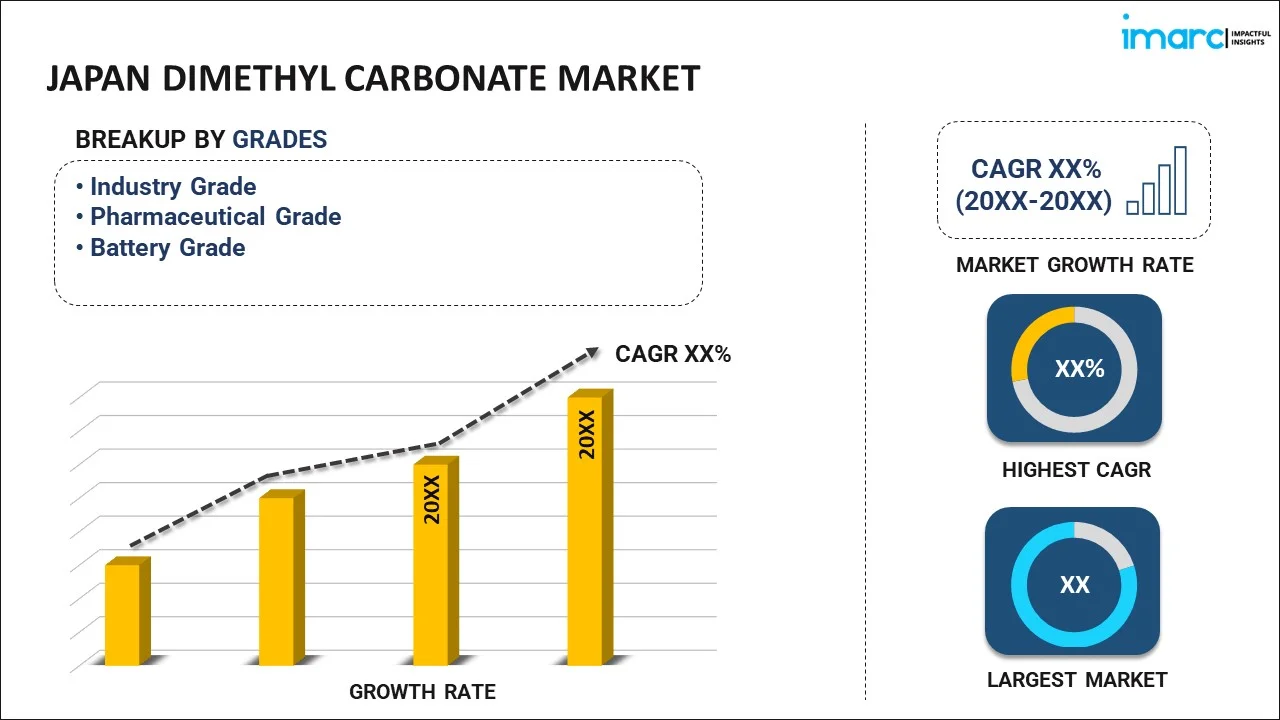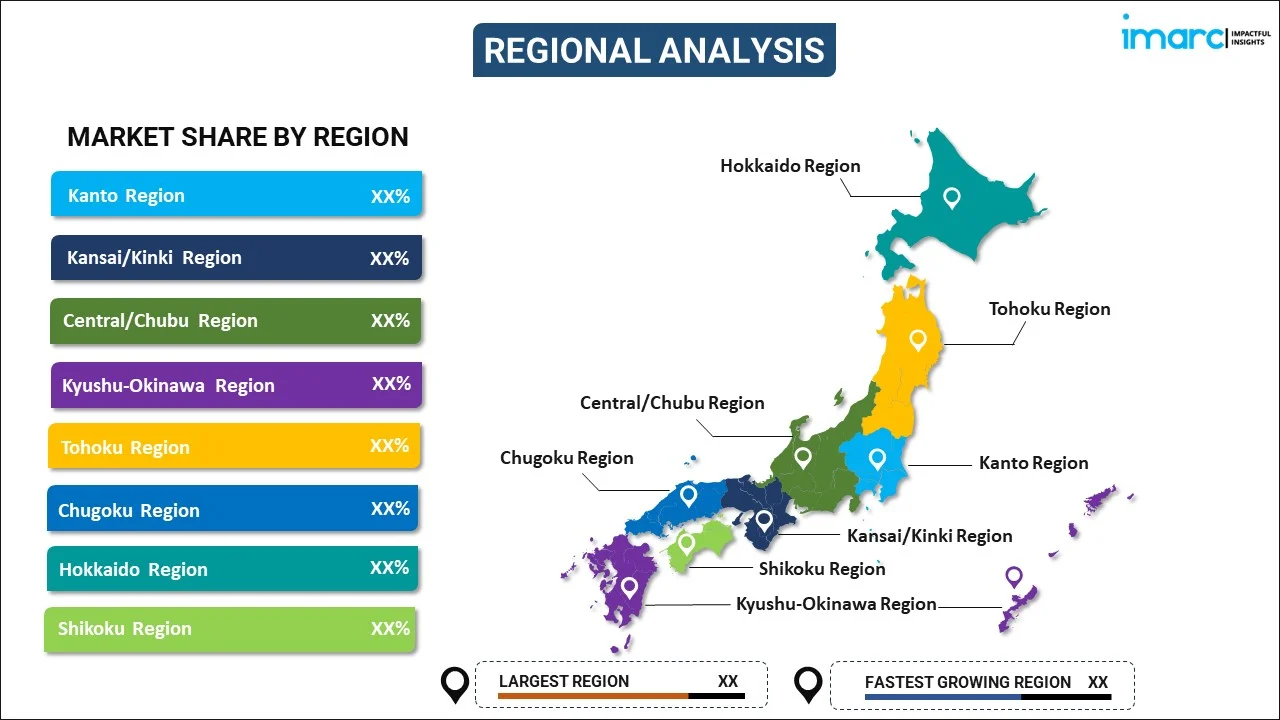
Japan Dimethyl Carbonate Market Report by Grade (Industry Grade, Pharmaceutical Grade, Battery Grade), Application (Polycarbonate Synthesis, Battery Electrolyte, Solvents, Reagents, and Others), End Use Industry (Plastics, Paints and Coating, Pharmaceutical, Electronics, Agrochemicals, and Others), and Region 2025-2033
Market Overview:
Japan dimethyl carbonate market size reached USD 70.2 Million in 2024. Looking forward, IMARC Group expects the market to reach USD 123.5 Million by 2033, exhibiting a growth rate (CAGR) of 6.5% during 2025-2033. The increasing awareness and concern for environmental sustainability, wide utilization of dimethyl carbonate in the chemical, pharmaceutical and cosmetics sectors, and continual research and development activities represent some of the key factors driving the market.
|
Report Attribute
|
Key Statistics
|
|---|---|
|
Base Year
|
2024 |
|
Forecast Years
|
2025-2033 |
|
Historical Years
|
2019-2024
|
| Market Size in 2024 | USD 70.2 Million |
| Market Forecast in 2033 | USD 123.5 Million |
| Market Growth Rate (2025-2033) | 6.5% |
Dimethyl carbonate (DMC) is a chemical compound that is a colorless, flammable liquid with a slightly sweet odor. DMC is a versatile organic compound that finds applications in various industries, including chemicals, pharmaceuticals, and as an eco-friendly solvent. Compared to traditional solvents, DMC is considered a green solvent because it has a low toxicity profile and is biodegradable. This makes it an attractive choice for industries looking to reduce their environmental footprint. In the chemical industry, dimethyl carbonate is used as a methylating agent in the synthesis of various organic compounds. It serves as a valuable reagent in the production of polymers, pharmaceuticals, and specialty chemicals. Additionally, it has applications as an electrolyte in lithium-ion batteries, contributing to the development of cleaner and more efficient energy storage solutions.
Japan Dimethyl Carbonate Market Trends:
The increasing awareness and concern for environmental sustainability is driving the market in Japan. Dimethyl Carbonate is considered an eco-friendly solvent as it is non-toxic and has low volatility. With stringent environmental regulations in place, industries are turning to Dimethyl Carbonate as a safer alternative to traditional solvents. Moreover, Japan has been a pioneer in the development of advanced energy storage solutions, including lithium-ion batteries. Dimethyl Carbonate plays a crucial role in the electrolyte formulation of these batteries. As the demand for electric vehicles and renewable energy storage solutions continues to rise, so does the demand for Dimethyl Carbonate. Additionally, Dimethyl Carbonate finds extensive use in the chemical industry as a versatile solvent. Its non-toxic nature and ability to dissolve a wide range of chemicals make it a preferred choice. Japan's robust chemical industry, involved in the production of various chemicals and polymers, relies on Dimethyl Carbonate for its processes. Besides, the pharmaceutical and cosmetics sectors are also significant consumers of Dimethyl Carbonate. It is used as a solvent in the production of pharmaceuticals and cosmetics due to its safety profile and ability to dissolve various active ingredients. Furthermore, ongoing research and development efforts to discover new applications for Dimethyl Carbonate have expanded its market potential. Innovative uses, such as in the production of polycarbonates and as a fuel additive, are continually being explored. Also, Japanese authorities have been supportive of environmentally friendly technologies and materials. They have implemented policies and incentives to encourage the adoption of green solvents, such as Dimethyl Carbonate. This regulatory support has further propelled the market. Also, Japan's focus on infrastructure development, including public transportation and urban planning, has led to increased demand for Dimethyl Carbonate. It is used in the production of construction materials, coatings, and sealants, contributing to the durability and sustainability of infrastructure projects.
Japan Dimethyl Carbonate Market Segmentation:
IMARC Group provides an analysis of the key trends in each segment of the market, along with forecasts at the country level for 2025-2033. Our report has categorized the market based on grade, application, and end use industry.
Grade Insights:

- Industry Grade
- Pharmaceutical Grade
- Battery Grade
The report has provided a detailed breakup and analysis of the market based on the grade. This includes industry grade, pharmaceutical grade, and battery grade.
Application Insights:
- Polycarbonate Synthesis
- Battery Electrolyte
- Solvents
- Reagents
- Others
A detailed breakup and analysis of the market based on the application have also been provided in the report. This includes polycarbonate synthesis, battery electrolyte, solvents, reagents, and others.
End Use Industry Insights:
- Plastics
- Paints and Coating
- Pharmaceutical
- Electronics
- Agrochemicals
- Others
The report has provided a detailed breakup and analysis of the market based on the end use Industry. This includes plastics, paints and coating, pharmaceutical, electronics, agrochemicals, and others.
Regional Insights:

- Kanto Region
- Kansai/Kinki Region
- Central/ Chubu Region
- Kyushu-Okinawa Region
- Tohoku Region
- Chugoku Region
- Hokkaido Region
- Shikoku Region
The report has also provided a comprehensive analysis of all the major regional markets, which include Kanto Region, Kansai/Kinki Region, Central/ Chubu Region, Kyushu-Okinawa Region, Tohoku Region, Chugoku Region, Hokkaido Region, and Shikoku Region.
Competitive Landscape:
The market research report has also provided a comprehensive analysis of the competitive landscape. Competitive analysis such as market structure, key player positioning, top winning strategies, competitive dashboard, and company evaluation quadrant has been covered in the report. Also, detailed profiles of all major companies have been provided.
Japan Dimethyl Carbonate Market Report Coverage:
| Report Features | Details |
|---|---|
| Base Year of the Analysis | 2024 |
| Historical Period | 2019-2024 |
| Forecast Period | 2025-2033 |
| Units | Million USD |
| Scope of the Report | Exploration of Historical and Forecast Trends, Industry Catalysts and Challenges, Segment-Wise Historical and Predictive Market Assessment:
|
| Grades Covered | Industry Grade, Pharmaceutical Grade, Battery Grade |
| Applications Covered | Polycarbonate Synthesis, Battery Electrolyte, Solvents, Reagents, Others |
| End Use Industries Covered | Plastics, Paints and Coating, Pharmaceutical, Electronics, Agrochemicals, Others |
| Regions Covered | Kanto Region, Kansai/Kinki Region, Central/ Chubu Region, Kyushu-Okinawa Region, Tohoku Region, Chugoku Region, Hokkaido Region, Shikoku Region |
| Customization Scope | 10% Free Customization |
| Post-Sale Analyst Support | 10-12 Weeks |
| Delivery Format | PDF and Excel through Email (We can also provide the editable version of the report in PPT/Word format on special request) |
Key Questions Answered in This Report:
- How has the Japan dimethyl carbonate market performed so far and how will it perform in the coming years?
- What has been the impact of COVID-19 on the Japan dimethyl carbonate market?
- What is the breakup of the Japan dimethyl carbonate market on the basis of grade?
- What is the breakup of the Japan dimethyl carbonate market on the basis of application?
- What is the breakup of the Japan dimethyl carbonate market on the basis of end use industry?
- What are the various stages in the value chain of the Japan dimethyl carbonate market?
- What are the key driving factors and challenges in the Japan dimethyl carbonate?
- What is the structure of the Japan dimethyl carbonate market and who are the key players?
- What is the degree of competition in the Japan dimethyl carbonate market?
Key Benefits for Stakeholders:
- IMARC’s industry report offers a comprehensive quantitative analysis of various market segments, historical and current market trends, market forecasts, and dynamics of the Japan dimethyl carbonate market from 2019-2033.
- The research report provides the latest information on the market drivers, challenges, and opportunities in the Japan dimethyl carbonate market.
- Porter's five forces analysis assist stakeholders in assessing the impact of new entrants, competitive rivalry, supplier power, buyer power, and the threat of substitution. It helps stakeholders to analyze the level of competition within the Japan dimethyl carbonate industry and its attractiveness.
- Competitive landscape allows stakeholders to understand their competitive environment and provides an insight into the current positions of key players in the market.
Need more help?
- Speak to our experienced analysts for insights on the current market scenarios.
- Include additional segments and countries to customize the report as per your requirement.
- Gain an unparalleled competitive advantage in your domain by understanding how to utilize the report and positively impacting your operations and revenue.
- For further assistance, please connect with our analysts.
 Inquire Before Buying
Inquire Before Buying
 Speak to an Analyst
Speak to an Analyst
 Request Brochure
Request Brochure
 Request Customization
Request Customization




.webp)




.webp)












